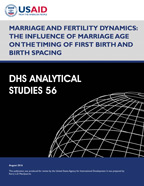- PUBLICATIONS
- JOURNAL ARTICLES
- ACCESS PUBLICATIONS
Publications Summary
- Document Type
- Analytical Studies
- Publication Topic(s)
- Family Planning, Fertility and Fertility Preferences, Youth
- Country(s)
- Bangladesh, Cambodia, India, Indonesia, Nepal, Pakistan, Philippines
- Language
- English
- Recommended Citation
- MacQuarrie, Kerry L.D. 2016. Marriage and Fertility Dynamics: The Influence of Marriage Age on the Timing of First Birth and Birth Spacing. DHS Analytical Studies No. 56. Rockville, Maryland, USA: ICF International.
- Download Citation
- RIS format / Text format / Endnote format
- Publication Date
- August 2016
- Publication ID
- AS56
Download
 Marriage and Fertility Dynamics: The Influence of Marriage Age on the Timing of First Birth and Birth Spacing (PDF, 1346K)
Marriage and Fertility Dynamics: The Influence of Marriage Age on the Timing of First Birth and Birth Spacing (PDF, 1346K)
